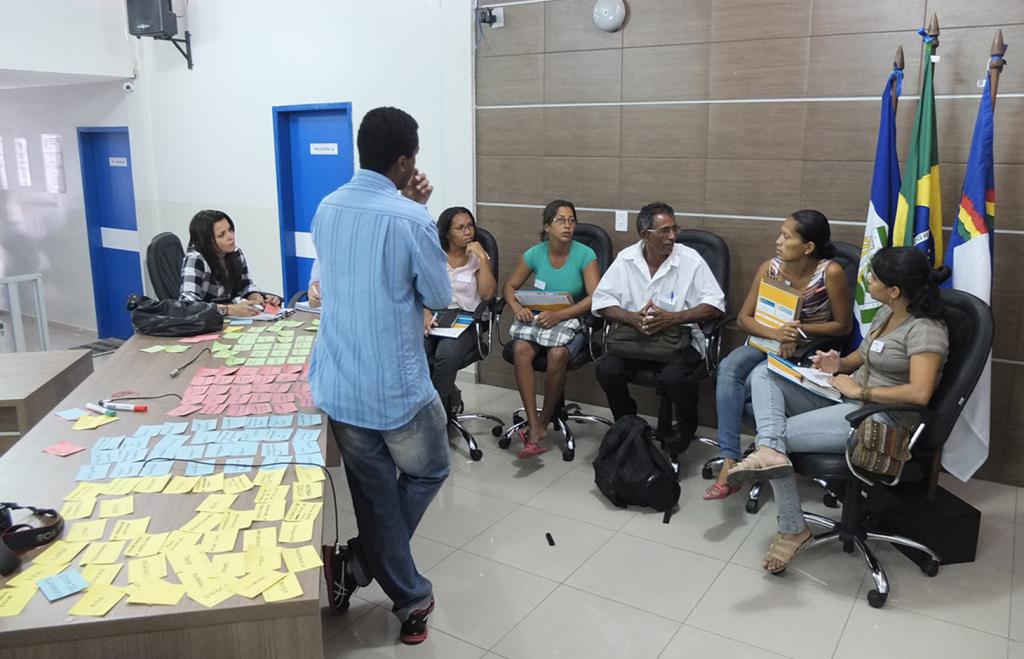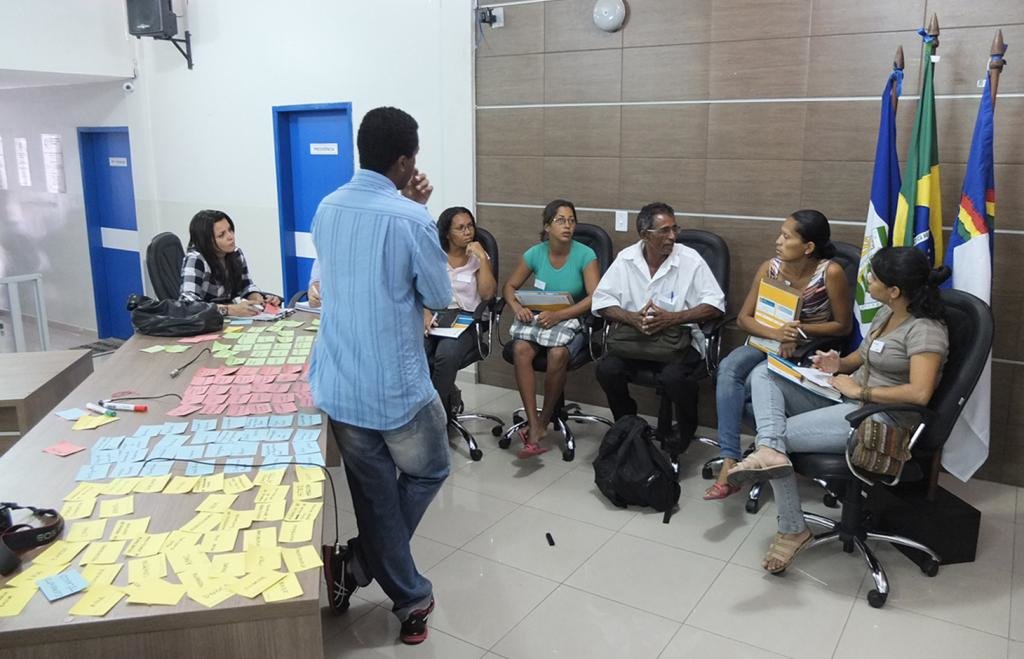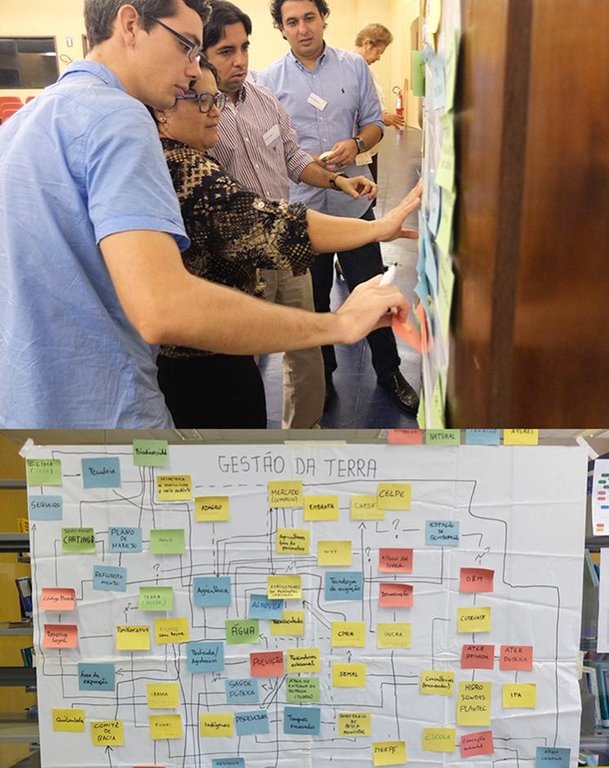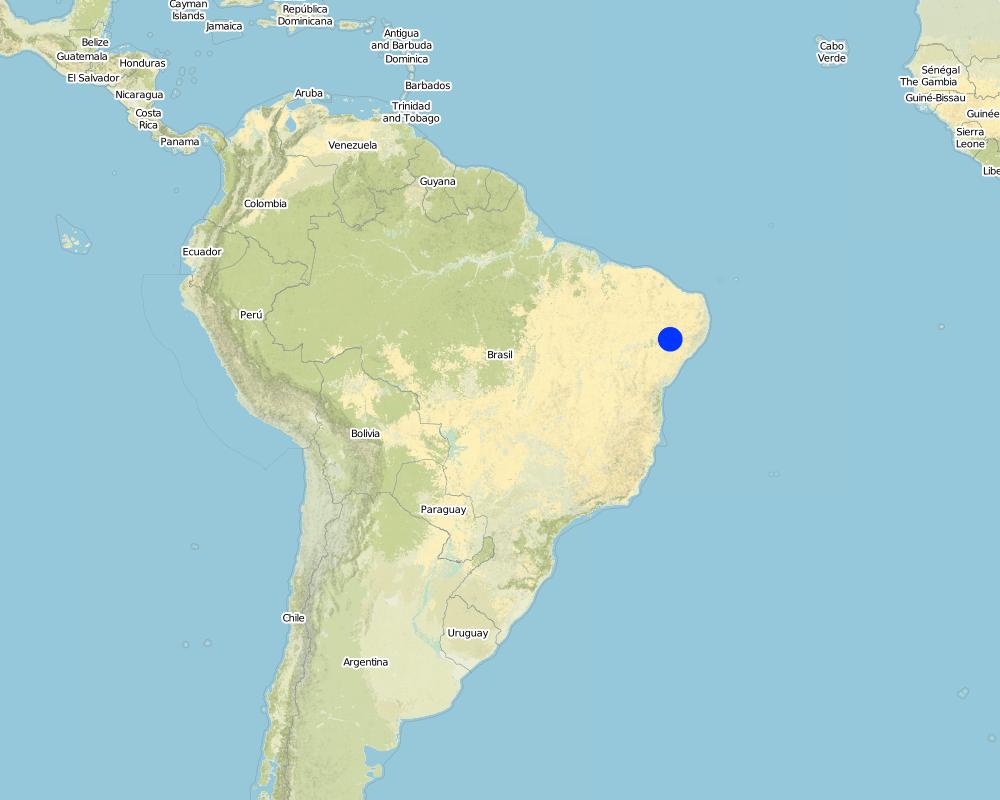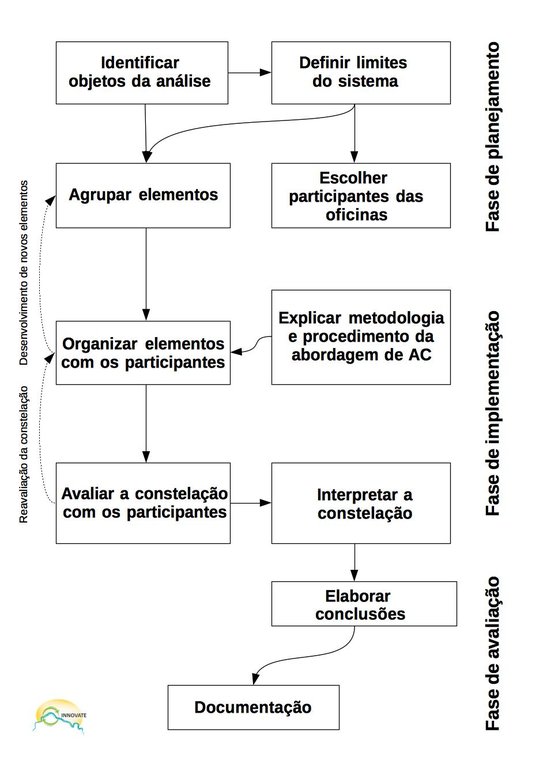Constellation Analysis [Brasil]
- Creación:
- Actualización:
- Compilador: Verena Rodorff
- Editor: –
- Revisor: Deborah Niggli
Análise de Constelação
approaches_1974 - Brasil
Visualizar secciones
Expandir todo Colapsar todos1. Información general
1.2 Detalles de contacto de las personas de referencia e instituciones involucradas en la evaluación y la documentación del Enfoque
Especialista MST:
Nombre del proyecto que facilitó la documentación/ evaluación del Enfoque (si fuera relevante)
Book project: Making sense of research for sustainable land management (GLUES)1.3 Condiciones referidas al uso de datos documentados mediante WOCAT
¿Cuándo se compilaron los datos (en el campo)?
23/06/2015
El compilador y la/s persona(s) de referencia claves aceptan las condiciones acerca del uso de los datos documentados mediante WOCAT :
Sí
2. Descripción del Enfoque MST
2.1 Breve descripción del Enfoque
Constellation Analysis is a tool used to clarify perceptions of different stakeholders about critical situations or problems. In workshops, participants visualize interrelationships between actors, as well as the associated natural, technical and regulatory factors.
2.2 Descripción detallada del Enfoque MST
Descripción detallada del Enfoque MST:
The Constellation Analysis method (CA) aims at a transparent, mutually accepted visualization of factors (‘elements’) that are systematically arranged under the method's four categories: actors; rules and concepts; natural elements; technical elements, with the type of their inter-relationships. The process enables consensus to be found between divergent positions, paving the way for better informed decision-making while facilitating a negotiated process of land management with potential changes/techniques.
During brainstorming and/or literature-based approach, different elements are determined and arranged visually on a board. Element categories are actors (e.g. farmers, energy supply company), rules and concepts (e.g. legal framework, plans and programs, regulations), natural factors (e.g. climate, vegetation, water) and technical factors (e.g. fertilizer, wastewater treatment, hydropower plant). Usually this is done by using differently coloured and shaped cards to help articulate ideas within a working group. Then, connections among and between the elements are discussed and the form of these interrelations are visualized as being (a) directed, (b) conflictive, (c) non-existent, (d) contradictory, (e) reluctant or (f) interactive. Through this approach the way towards developing solutions (or follow-up CAs) is guided.
The approach was applied at different scales and with different stakeholders with divergent professional expertise and educational levels, e.g. farmers, fishermen, employees of the government, representatives of indigenous tribes, associations, trade unions, and researchers. People found the methodology promising as it raises awareness and organizes information. Training in the methodology has been carried out amongst interested people at two universities, but not yet local development agents.
The visualization is carried out through an iterative group process. A moderator is needed to initiate the process by inviting the different stakeholders to a conducive location, and to facilitate the process. Exchange among participants is enhanced, and this leads to better understanding of different viewpoints in situations of tension or in the understanding of what has evolved through specific developments in the past. During a second analytical step, the main lessons of the visualization are extracted and documented. Here, missing factors/relationships, and consequently the need for action, are detected. For example, insufficient communication between actors could be uncovered, or it may be detected that planning programs need to be improved.
2.3 Fotos del Enfoque
2.5 País/ región/ lugares donde el Enfoque fue aplicado
País:
Brasil
Región/ Estado/ Provincia:
Pernambuco, Brazil
Especifique más el lugar :
Itaparica Reservoir, Petrolândia
Map
×2.6 Fechas de inicio y conclusión del Enfoque
Indique año del inicio:
2012
Año de conclusión (si el Enfoque ya no se aplica):
2016
2.7 Tipo de Enfoque
- proyecto/ basado en un programa
2.8 Propósitos/ objetivos principales del Enfoque
The approach can be applied at different levels and for different issues or contexts: all perspectives can be represented and discussed. The application in this case was devised to be an iterative process of consecutive workshops first at the local irrigation project level, and then at the municipal, regional and national levels with the aim of analysing the inhibiting and driving forces behind the current situation in water management, in land management, and around production cycles in agriculture and aquaculture leading to action being taken or decisions made. Farmers and fishermen, employees of government, researchers and experts are considered as the relevant target group to be involved in participatory workshops. In the education sector, the approach can be applied for theses, for field work and for projects as an analytical interdisciplinary approach.
2.9 Condiciones que facilitan o impiden la implementación de la/s Tecnología/s aplicadas bajo el Enfoque
normas y valores sociales/ culturales/ religiosos
- facilitan
In some cases, segregation of social or gender groups, especially at the beginning of the exercise, can be helpful. No means has yet been found to reduce ‘mobile phone distraction’ in an acceptable way.
entorno institucional
- facilitan
Argumentation promoting the value of the process may help to ‘sell’ the approach.
conocimiento de MST, acceso a apoyo técnico
- facilitan
It may be possible to organize a pick-up service for participants or to choose an easy-access location.
carga de trabajo, disponibilidad de mano de obra
- facilitan
It is important to discuss potential dates in advance. Some people prefer weekends, others don’t. The lunch break is useful for more informal interaction. However others use the break to disappear.
otros
- facilitan
The iterative process of the CA promotes a re-assessment of constellations during different group discussions. Views of dominant individuals can be modified in the iterative procedure, especially when participants with different standpoints and positions are involved. The goal is the mutual understanding of divergent positions towards entry points for change or adaptation.
3. Participación y roles de las partes interesadas involucradas
3.1 Partes interesadas involucradas en el Enfoque y sus roles
- usuarios locales de tierras/ comunidades locales
smallholders of local agricultural community
- especialistas MST/consejeros agrícolas
- profesores/ niños en edad escolar/ estudiantes
students only in observing role
- gobierno nacional (planificadores, autoridades)
3.2 Involucramiento de los usuarios locales de tierras/ comunidades locales en las distintas fases del Enfoque
| Involucramiento de los usuarios locales de tierras/ comunidades locales | Especifique quién se involucró y describa las actividades | |
|---|---|---|
| iniciación/ motivación | pasivo | Interviews |
| planificación | ninguno | |
| implementación | interactivo | Workshops |
| monitoreo y evaluación | interactivo | Workshops |
| research | interactivo | Data analysis, lessons learnt, etc |
3.3 Flujograma (si estuviera disponible)
Descripción:
Simplified flowchart of the Constellation Analysis Approach.
Planning phase:
Clarify the objective or question behind the analysis. Then, have an overview research about first elements (assembling elements), e.g. which actors can give interesting input and how to contact them. Preparing material for the workshop(s): coloured cards, pens, whiteboard, etc.
Implementation phase:
Explain the objective and methodology to participants, the meaning of the elements: actors; rules and concepts; natural elements; technical elements and their different relations. Clarify rules of respecting each other. Arrange the elements. Evaluate the constellation together with participants, e.g. why are elements far or close to each other? Why are relations conflictive and how to overcome? Are elements or relations missing? Is all information available? What are the next step? Can recommendations be formulated?
Evaluation phase:
Were participants objective enough? How to interpret participant’s activity within the workshop? Which actors should be asked as well? Consolidate participants’ statements with literature and research and document. Documentation could be a photo or digitalized picture of results with an explanation based on literature.
Autor:
Liron Steinmetz
3.4 La toma de decisiones en la selección de Tecnología(s) MST
Especifique quién decidió la selección de las Tecnología/ Tecnologías a implementarse:
- principalmente usuarios de tierras con el apoyo de especialistas MST
Explique:
Constellation Approach is not linked with a specific technology. Can be used in a planning phase in sustainable land management. Various methods, technologies and management approaches can be derived from the applied Constellation CA Approach, and can be specified depending on the SLM problem.
4. Apoyo técnico, fortalecimiento institucional y gestión del conocimiento
4.1 Construcción de capacidades / capacitación
¿Se proporcionó la capacitación a usuarios de tierras/ otras partes interesadas?
Sí
Especifique quién fue capacitado:
- usuarios de tierras
- personal de campo/ consejeros
Forma de capacitación:
- workshops
Temas avanzados:
detecting knowledge gaps and clarifying positions of players, and role of natural, technical and regulatory elements from multi-angled viewpoints/perspectives as core of the CA-Approach.
4.2 Servicio de asesoría
¿Los usuarios de tierras tienen acceso a un servicio de asesoría?
Sí
- workshops
4.3 Fortalecimiento institucional (desarrollo institucional)
¿Se establecieron o fortalecieron instituciones mediante el Enfoque?
- no
4.4 Monitoreo y evaluación
¿El monitoreo y la evaluación forman parte del Enfoque?
Sí
Si respondió que sí, ¿la documentación se utilizará para monitoreo y evaluación?
No
4.5 Investigación
¿La investigación formó parte del Enfoque?
Sí
Especifique los temas:
- sociología
- economía/ marketing
- ecología
- tecnología
5. Financiamiento y apoyo material externo
5.1 Presupuesto anual para el componente MST del Enfoque
Si no se conoce el presupuesto anual preciso, indique el rango:
- < 2,000
Comentarios (ej. fuentes principales de financiamiento/ donantes principales):
German Federal Ministry of Education and Research (BMBF) 100%
5.2 Apoyo financiero/material proporcionado a los usuarios de tierras
¿Los usuarios de tierras recibieron financiamiento/ apoyo material para implementar la Tecnología/ Tecnologías? :
No
5.3 Subsidios para insumos específicos (incluyendo mano de obra)
- ninguno
Si la mano de obra de usuarios de tierras fue un insumo sustancial, ¿fue:
- voluntario?
5.4 Crédito
¿Se proporcionó crédito bajo el Enfoque para actividades MST?
No
5.5 Otros incentivos o instrumentos
¿Se usaron otros incentivos o instrumentos para promover la implementación de Tecnologías MST?
No
6. Análisis de impacto y comentarios de conclusión
6.1 Impactos del Enfoque
¿El Enfoque ayudó a los usuarios de tierras a implementar y mantener Tecnologías MST?
- No
- Sí, un poco
- Sí, moderadamente
- Sí, mucho
No immediate impact, however CA-Approach could prospectively contribute to improved sustainable land management and in particular governance.
¿El Enfoque empoderó a grupos en desventaja social y económica?
- No
- Sí, un poco
- Sí, moderadamente
- Sí, mucho
No immediate impact, however CA-Approach could prospectively contribute to an improved situation of socially and economically disadvantaged groups.
Did other land users / projects adopt the Approach?
- No
- Sí, un poco
- Sí, moderadamente
- Sí, mucho
Interest from cooperating universities (UFPE-Universidade Federal de Pernambuco, IFPE-Instituto Federal de Pernambuco).
Did the Approach lead to improved livelihoods / human well-being?
- No
- Sí, un poco
- Sí, moderadamente
- Sí, mucho
No immediate impact, however CA-Approach could prospectively contribute to improved well-being.
6.2 Motivación principal del usuario de la tierra para implementar MST
- producción incrementada
- prestigio, presión social/ cohesión social
- afiliación al movimiento/ proyecto/ grupo/ redes
- conciencia medioambiental
6.3 Sostenibilidad de las actividades del Enfoque
¿Pueden los usuarios de tierras sostener lo que se implementó mediante el Enfoque (sin apoyo externo)?
- sí
Si respondió que sí, describa cómo:
Attained knowledge on a complex, perhaps previously nontransparent system and established contacts support future decision making. In general CA is a flexible method that can be applied by any group, preferentially mixed stakeholder groups.
6.4 Fortalezas/ ventajas del Enfoque
| Fuerzas/ ventajas/ oportunidades desde la perspectiva del usuario de la tierra |
|---|
| Results can be used for the planning of regional development. |
| Space for interchange of ideas and establishing contacts. |
| Integrates different views of problems. |
| Facilitates participation possibilites for stakeholders. |
| Fuerzas/ ventajas/ oportunidades desde la perspectiva del compilador o de otra persona de referencia clave |
|---|
| Allows expression and discussion of different views, knowledge integration, both inter- and transdisciplinary, characterised by an iterative and participative nature, able to detect complex situations and questions. |
6.5 Debilidades/ desventajas del Enfoque y formas de sobreponerse a ellos
| Debilidades/ desventajas/ riesgos desde la perspectiva del usuario de la tierra | ¿Cómo sobreponerse a ellas? |
|---|---|
| Insufficient space for all to participate, topics covered in too little time. As more than one workshop is needed, the approach does not necessarily provide solutions in the end. | Prepare goal-orientated workshops and finish a workshop by identifying potential solutions and formulating recommendations. I is important to well document and report on the workshops and distribute the reports to stakeholders. |
| Debilidades/ desventajas/ riesgos desde la perspectiva del compilador o de otra persona de referencia clave | ¿Cómo sobreponerse a ellas? |
|---|---|
| One workshop cannot manage to convey the dynamics of a situation. | Formulate recommendations for action and distribute a report to stakeholders. |
| CA only visualizes the current situation. Different future scenarios over a given timespan can be presented only in a series of single CA visualizations. | CA could lay the groundwork for scenario modelling approaches (e.g. Bayesian Networks). |
| One workshop cannot manage to convey the dynamics of a situation. | Formulate recommendations for action and distribute a report to stakeholders. |
7. Referencias y vínculos
7.1 Métodos/ fuentes de información
- visitas de campo, encuestas de campo
- entrevistas con usuarios de tierras
7.2 Referencias a publicaciones disponibles
Título, autor, año, ISBN:
): Rodorff V.et al. (2013a) Driving forces and barriers for a sustainable management of the Itaparica reservoir region - basic milestones towards a constellation analysis.
¿Dónde se halla disponible? ¿Costo?
Gunkel G. et al. (Eds.) (2013) Sustainable Management of Water and Land in Semiarid Areas. Editora Universitária UFPE, Recife, pp 2
Título, autor, año, ISBN:
Rodorff, V., Siegmund-Schultze, M., Köppel, J., Gomes, E.T.A. (2015) Governança da bacia hidrográfica do rio São Francisco: Desafios de escala sob olhares inter e transdisciplinares.
¿Dónde se halla disponible? ¿Costo?
Revista Brasileira de Ciências Ambientais 36, 30-56.
Vínculos y módulos
Expandir todo Colapsar todosVínculos
No hay vínculos
Módulos
No se hallaron módulos


